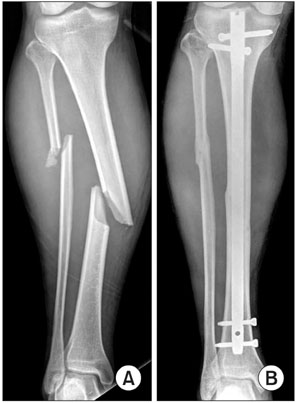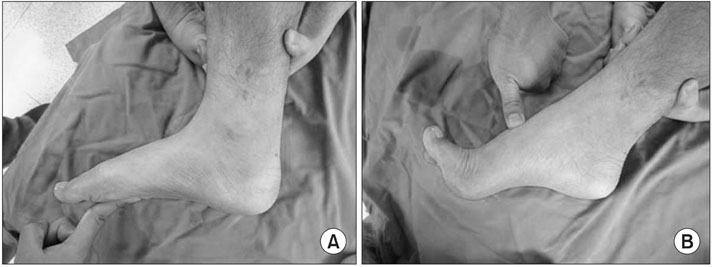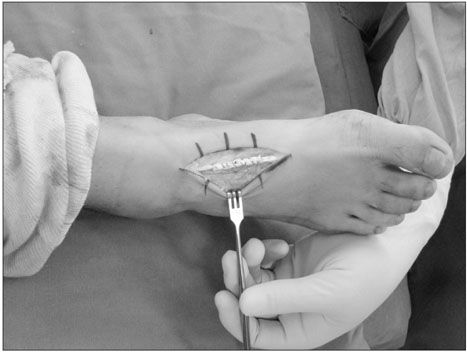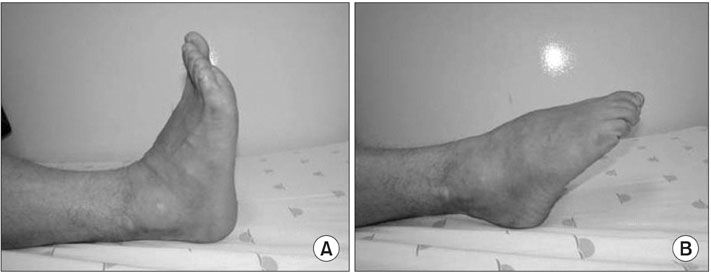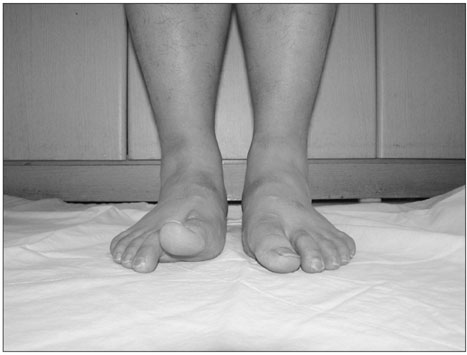J Korean Orthop Assoc.
2010 Oct;45(5):399-403.
Contracture of Extensor Hallucis Longus Tendon Occurring after Intramedullary Nailing for a Tibial Fracture
- Affiliations
-
- 1Department of Orthopedic Surgery, Konyang University Hospital, Daejeon, Korea. ajouos@hanmail.net
Abstract
- Toe deformities occurring after tibial shaft fracture can result from compartment syndrome or adhesion of muscle to tendon. Claw toes or checkrein deformity caused by injury of posterior compartment muscles has been reported relatively often. But, a deformity due to injury of the anterior compartment muscles is very rare. We observed the two cases of an extension deformity at the metatarsophalangeal joint of the hallux following intramedullary nailing of a tibial shaft fracture. There was no evidence of compartment syndrome. Extension deformity of the hallux was decreased with dorsiflexion of the ankle and increased with plantar flexion. Contracture of the extensor hallucis longus tendon was diagnosed, and Z-lengthening of that tendon was performed. Satisfactory results were obtained without a recurrence of deformity. We report these rare cases of toe deformities occurring after a tibial shaft fracture, with a brief review of the literature.
MeSH Terms
Figure
Reference
-
1. Karlström G, Olerud S. Fractures of the tibial shaft; a critical evaluation of treatment alternatives. Clin Orthop Relat Res. 1974. 105:82–115.2. Feeney MS, Williams RL, Stephens MM. Selective lengthening of the proximal flexor tendon in the management of acquired claw toes. J Bone Joint Surg Br. 2001. 83:335–338.
Article3. Lee HS, Kim JS, Park SS, Lee DH, Park JM, Wapner KL. Treatment of checkrein deformity of the hallux. J Bone Joint Surg Br. 2008. 90:1055–1058.
Article4. Rorabeck CH, Macnab L. Anterior tibial-compartment syndrome complicating fractures of the shaft of the tibia. J Bone Joint Surg Am. 1976. 58:549–550.
Article5. Moed BR, Strom DE. Compartment syndrome after closed intramedullary nailing of the tibia: a canine model and report of two cases. J Orthop Trauma. 1991. 5:71–77.6. Leung YF, Ip SP, Chung OM, Wai YL. Unimuscular neuromuscular insult of the leg in partial anterior compartment syndrome in a patient with combined fractures. Hong Kong Med J. 2003. 9:214–216.7. Sharma G, Makwana NK, Guha AR. Extensor hallucis longus tendon contracture following triplane fracture of the tibia. Foot Ankle Surg. 2007. 13:76–79.
Article8. Robinson CM, O'Donnell J, Will E, Keating JF. Dropped hallux after the intramedullary nailing of tibial fractures. J Bone Joint Surg Br. 1999. 81:481–484.
Article9. Rorabeck CH, Clarke KM. The pathophysiology of the anterior tibial compartment syndrome: an experimental investigation. J Trauma. 1978. 18:299–304.10. Lui TH. Arthroscopically assisted Z-lengthening of extensor hallucis longus tendon. Arch Orthop Trauma Surg. 2007. 127:855–857.
Article
- Full Text Links
- Actions
-
Cited
- CITED
-
- Close
- Share
- Similar articles
-
- Delayed Rupture of the Extensor Pollicis Longus Tendon Following Intramedullary Nailing of Radial Shaft Fracture
- The Checkrein Deformity of Extensor Hallucis Longus Tendon and Extensor Retinaculum Syndrome with Deep Peroneal Nerve Entrapment after Triplane Fracture: A Case Report
- Reconstruction of Chronic Extensor Hallucis Longus Tendon Rupture Using Interposed Scar Tissue: A Case Report
- Rupture of the Extensor Pollicis Longus after Fracture of the Distal end of the Radius: Report of 3 cases
- Complete Rupture of the Extensor Hallucis Longus Tendon with Accessory Slip Mimicking a Partial Rupture: A Case Report

